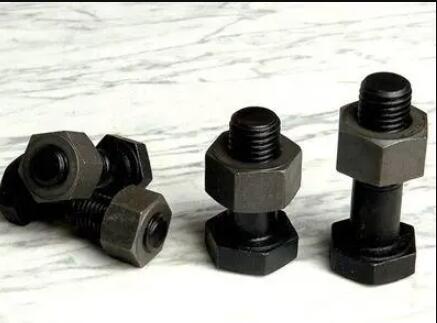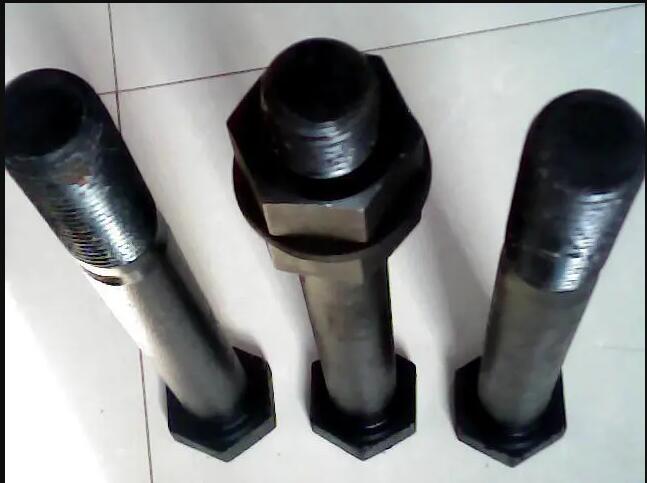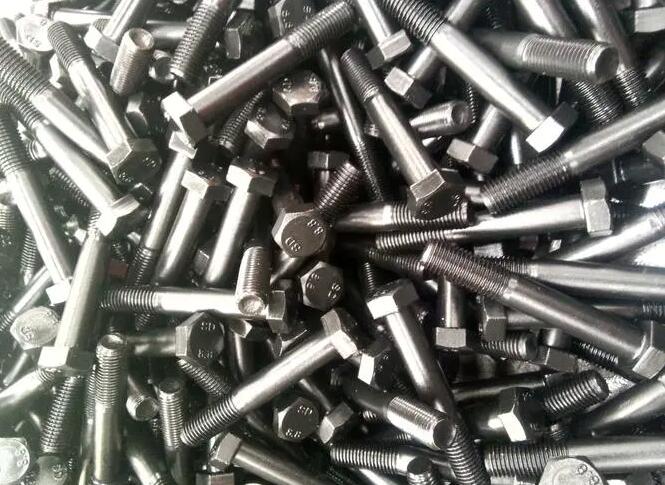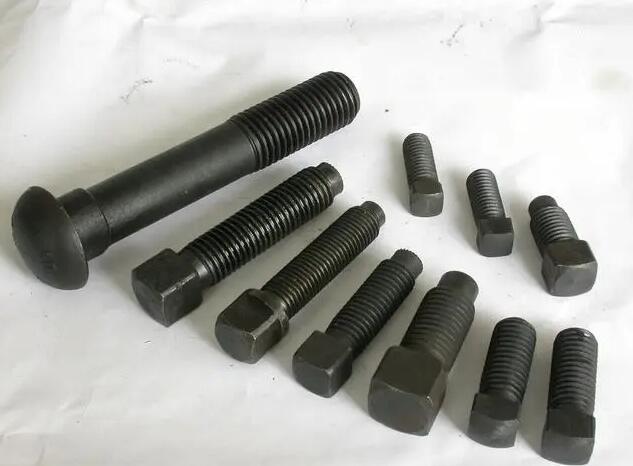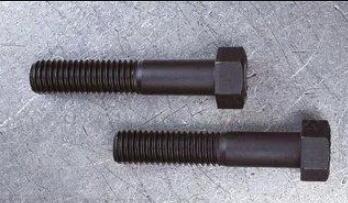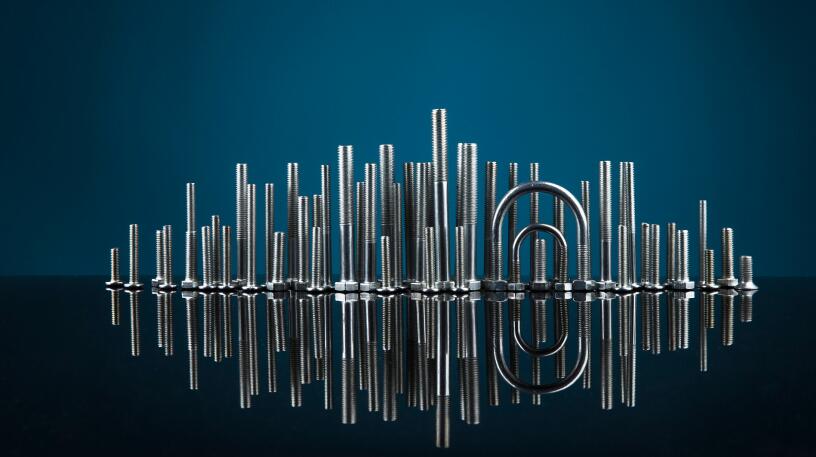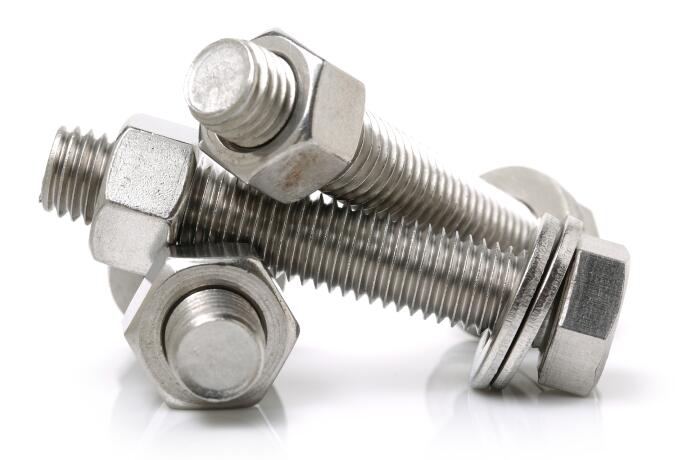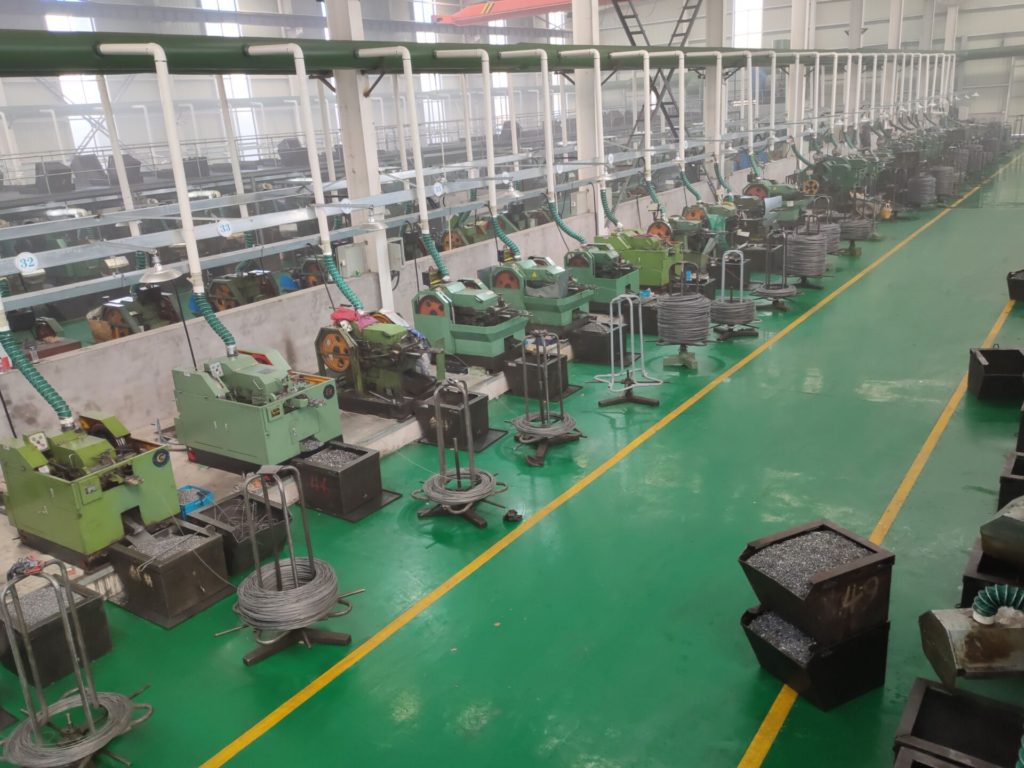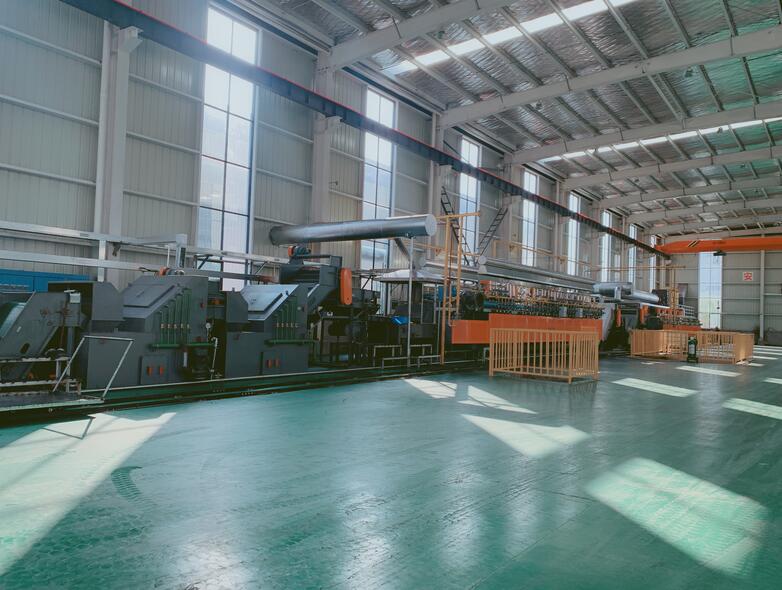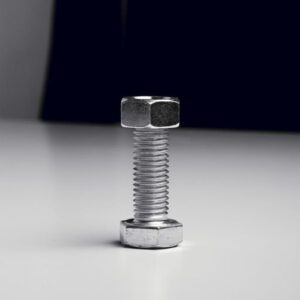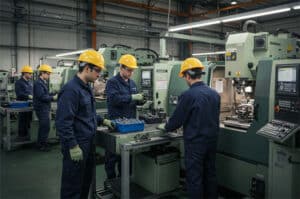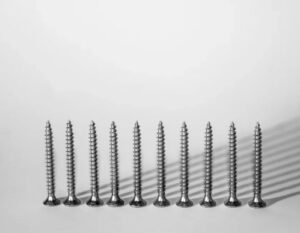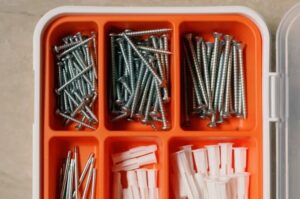Prince Fastener:High-strength bolt material selection and product processing technology
Bolts are an essential standard used as connecting fasteners and are widely used in various fields. Their different mechanical and physical properties are divided into 10 categories, among which bolts with a mechanical property level greater than or equal to 8.8 we usually call high-strength bolts.
The most significant difference between high-strength and ordinary bolts lies in their high tensile strength, high surface hardness, and good mechanical properties. The key lies in the selection of materials and the difference in heat treatment. Heat treatment of high-strength bolts generally refers to quenching and tempering, that is, quenching + high-temperature tempering.
The hardness value can estimate the approximate tensile strength value of the material. You can refer to the relevant manuals, usually detect the hardness value of the bolt, and calculate the corresponding tensile strength value.
Tensile tests must also be performed regularly to determine the tensile strength. There are many types of metal surface treatments that are commonly used: surface oxidation, dacromet, galvanized, and surface phosphating. Surface phosphating or surface oxidation is recommended for surface treatment of high-strength bolts.
The close integration and cooperation between the smelting industry and the automobile industry will further promote the research of modern alloy technology and provide a material basis for the development of automotive high-strength fasteners and the improvement of competitiveness, which requires full attention from the entire industry.
- Structural characteristics and process analysis of high-strength bolts There are many types of high-strength bolts (see), and the shapes are not the same. Based on these similarities, we divide it into three main parts: the head, the stem, and the threaded part.
- The machining of high-strength bolts generally does not require special machine tools with extremely high precision and can be processed on standard equipment. According to its three main parts, its machining process can be divided into three parts: the machining of the head, the machining of the shank, and the machining of the thread.
- The processing technology of each part is divided into several types due to the difference in size, shape, and technical requirements, and different processing methods are used; however, it is divided into three parts; the processing of the three parts is complementary and interrelated and may coexist in the same Processes may also coexist in the same process step.
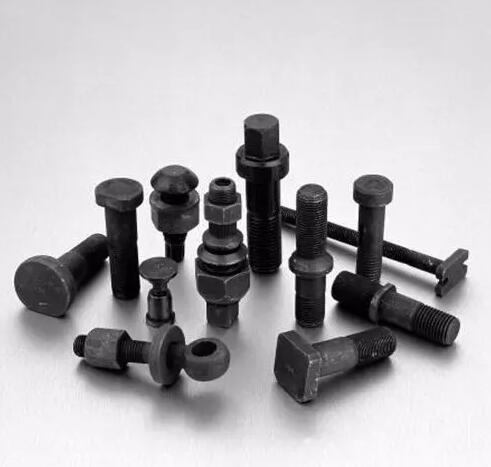
The primary function of the head is to apply a reverse torque when the nuts and the bolt are matched to ensure that the nut has sufficient tightening torque. There are many kinds of forms, mainly in the form of square heads, semi-circle heads, hexagonal heads, etc. In addition, some non-standard parts of the high-strength bolt head form are specially designed by the designer according to the assembly needs.
The shape of the bolt head directly determines the form of the product blank. Generally speaking, cold-drawn square steel can be used for square head bolt blanks, cold-drawn hexagonal steel can be used for hexagonal head bolt blanks, forging blanks should be used for semi-circle head bolt blanks; for bolts with specially designed head shapes, blanks should be selected according to specific shapes. ,
To avoid increasing the processing process of the head, it is recommended to use forging blanks when the technical requirements allow; if the maximum contained size of the head and the outer circle size of the rod have a significant difference or the overall length size is large, to reduce material waste and To reduce processing time, it is recommended to use forging blanks.
Reserved machining allowance for blanks: The reserved machining allowance mainly refers to the length direction for shaped steel blanks. Under normal circumstances, it is enough to reserve a 4mm allowance in the length direction and at the same time to ensure the utilization rate of blanking; if the length of a single blank is small, it can be considered to make multiple parts from one blank.
For forging blanks, under the premise that the technical requirements allow, the shape of the head should be directly forged and formed, and the inner end face of the head should reserve a margin of 1.5mm. The head forming process can be completed on an ordinary lathe. The inner end face of some high-strength bolts and the rod’s centerline have end face runout and verticality requirements, which are generally between 0.04 and 0.10 mm.
At this time, the head width generally reserves a machining allowance of 0.2 mm during rough machining, and the rod is finished. When selecting the outer circle, the precision is higher. The machine tool relies on the precision of the machine tool itself to ensure the requirements of the shape and position tolerance of the inner end face of the head.
To ensure the tensile Strength of high-strength bolts, the required chamfering value at the inner end face is generally ±0.2. The rod part mainly plays a guiding role, especially the guide diameter bolts, which bear a specific radial shear force after assembly and are required to be smaller than the hole diameter. The clearance fit requires strict requirements on the accuracy and roughness of the outer circle of the rod. Some bolts that only bear the axial tensile force after assembly is not very strict on the rod part, and the outer circle dimensional tolerance is large.
For high-strength bolts, the contact part between the shank and the head requires a specific rounded corner to avoid breakage of this part when subjected to a large tensile force and to avoid cracks during heat treatment and cooling, which are the key factors to pay attention to in processing.
A 1.5mm allowance is reserved for machining on one side of the outer circle of the rod. To avoid large deformation during heat treatment, a 2mm allowance can be reserved for the slender bolts on the rod, or the blank can be directly quenched and tempered to the required hardness. Still, the hardness is not easy to exceed High, generally below HRC32.
The technical requirements for forging blanks stipulate the requirements for the surface defect layer, the coaxiality of the head, and the rod. The specific value depends on the product requirements, and the general value is not more than 0.3mm. If there are no special requirements after forging, the forgings should be normalized to reduce the hardness. Suitable for subsequent machining. The processing of the rod is mainly the external surface processing, and turning and grinding are the central processing methods.
Turning the outer circle, when the dimensional accuracy and surface roughness of the outer circle of the bolt shank is not high, the final size and accuracy of the outer circle can be obtained by turning. Generally, the rough turning accuracy can reach IT12~mi, and the surface roughness Ra value is about 50 ~12.5pm; generally, use a more significant depth of cut, larger feed rate, and lower cutting speed; semi-finishing accuracy can reach IT10~IT9, surface roughness Ra value is about 6.3~3.2pm, depth of cut and The feed rate is smaller than that of rough turning.
When turning the outer circle, the head of the bolt is the clamping part, and the width of the head is small, so the other end face needs to be clamped and positioned by the center hole. This requires drilling the center hole of the end face before turning the outer surface, and the size depends on the size of the bolt and the type of material. When the dimensional accuracy and surface roughness of the outer circle surface is required to be high, other processes need to be added after turning the outer circle, mainly referring to grinding. A margin of 0.2~0.45mm is reserved on both sides, and the long diameter of the rod is relatively large or needs to be ground multiple times. For processing, the allowance shall be the more significant value.
The threaded part is the central part of the bolt. It can be divided into three parts: the practical thread part, the end part (retraction part), and the end of the thread; the three main elements of the thread: are the pitch, the half-angle of the tooth shape, and the pitch, which directly affect the accuracy of the thread fit and are also the key elements of processing.
Grinding the outer circle generally adopts centerless cylindrical grinding, which has high production efficiency and convenient and straightforward operation. Still, it is more troublesome to adjust the machine tool. The grinding of the grinding wheel also requires a certain technical level, especially the bolts with runout and verticality requirements on the inner end face of the head; its shape and position tolerance are guaranteed by the precision of the grinding wheel.
The grinding wheel must be strictly trimmed. There are many thread processing methods, such as turning, milling, grinding and rolling, etc. For high-strength bolts, rolling threads are the best choice. Thread rolling is a chip-free processing technology. The thread is formed by plastic deformation of the surface of the blank. This processing technology has high productivity, the precision can reach 4h, and the surface roughness can reach Ra0.2pm.
When rolling the thread, the workpiece material fiber is not only not cut but is further strengthened due to work hardening and low surface roughness. Since the thread is extruded, the blank diameter of the rolling thread is smaller than that of the cutting thread. Thus, 16%~25% can be saved. However, the rolling thread has higher requirements on the dimensional accuracy of the blank diameter. A grinding machine or ordinary lathe can process the processing of blank diameter.
The end of the thread needs to reserve a specific space for retraction, about 2~3mm. 2 The steel of high-strength bolts is selected in the manufacture of fasteners, and the correct selection of fastener materials is an essential part because the performance of fasteners and its Materials are closely related. Suppose the material is improperly or incorrectly selected. In that case, the performance may not meet the requirements, the service life may be shortened, accidents or processing difficulties may occur, and the manufacturing cost will be high.
Therefore, the selection of fastener materials is an essential link. Cold heading steel is the steel for fasteners with high interchangeability produced by the cold heading forming process. Because it is formed by metal plastic processing at room temperature, each part has a large deformation and a high deformation speed. Therefore, the performance requirements of cold heading steel raw materials are stringent.
Based on long-term production practice and user research, they are combined with GB/T6478-2001 steel technical conditions for cold heading and cold extrusion GB/T699-1999 high-quality carbon structural steel and target ISG3507-1991 carbon steel for cold heading steel; the characteristics of wire rod, taking the material requirements of grade 8.8 and grade 9.8 bolts and screws as an example, the determination of various chemical elements.
If the C content is too high, the cold forming performance will be reduced; if it is too low, the mechanical properties of the parts cannot be met, so it is set at 0.25%~0.55%. Micro-alloyed steel changes the steel by adding a small amount of a specific element performance to improve the working Strength of fasteners because each element has its characteristics. Depending on the content of other elements in the steel, the production process, and the requirements for use, these elements can be used separately or in combination.
For a long time, 8.8-grade bolts are usually made of ML35 steel after quenching and tempering. There are specific problems in both production and use, such as cold heading cracking, easy quenching cracking, and decarburization during heat treatment. Hexagon head grinding and other issues. CH35ACR cold heading steel is a more considerable specification bolt material that replaces ML35 steel for M14. Comparing CH35 steel and ML35 steel, there are differences in Si and Mn content.
The former adds the Ci element and reduces the content of P and S; the critical diameter of quenching after cooling in oil is increased to 18~20mm, the hardness difference after tempering at the same high temperature is relatively large, and the tempering resistance is strong. In recent years, steel’s cold heading alloying technology has made significant progress. On the one hand, alloying has made significant progress. In C-Mn steel.
Using non-quenched and tempered steel to make bolts can omit the spheroidizing annealing before the cold drawing of the bolts and the quenching and tempering treatment after the bolts are formed. Since the hardness of the non-quenched and tempered steel wire rod is higher than usual when cold working, this reduces the life of the processing tool, therefore, the bolts made of non-quenched and tempered steel mainly grade 8.8, and the stud bolts of grade 10.9 with less processing volume can also be made of non-quality steel, and their usage is gradually expanding.
The non-quenched and tempered steel currently used is a low carbon and manganese ferrite + pearlite and bainite. In production, out-of-furnace refining is used to reduce inclusions and control the composition in a narrow range. The structure is refined through controlled rolling and controlled cooling to improve toughness and produce precipitation strengthening. ML08Mn2Si dual-phase cold heading steel is developed to replace ML35 steel.
It has high strength and excellent cold forming properties, mainly in that it can improve the cold heading property of steel and increase the utilization rate of steel. It achieves the strength requirements of bolts through cold-drawing deformation strengthening, thus simplifying the hot working process of fasteners, saving energy consumption, and having high economic value and social benefits.
Generally, after conventional heat treatment of medium carbon (alloy) structural steel, its Strength and flexibility are a pair of contradictions of mutual trade-off. Strength: If you want to maintain a high strength level, quenching and low-temperature tempering are used, but it appears to be insufficient in plasticity and toughness. After quenching, the structure of low carbon (alloy) structural steel is low carbon martensite + lath phase boundary retained austenite and fine and dispersed carbides during inclusion.
This structure is an intergranular dislocation structure with high Strength (hardness 45~50HRC), yield strength is 1000~1300MPa, good plasticity A body 10%, Z body 40%, and toughness Ah body 59, as well as good cold workability, weldability, and heat treatment distortion are minor. Other advantages include the research and development of low carbon martensitic structural steel with essential theoretical and practical significance. Critical bolts on automobiles, such as connecting rod bolts, cylinder head bolts, half-shaft bolts, etc., were generally made of 40Cr or 35CrM steel in the past. Due to their poor cold heading performance, a large amount of waste is often generated due to cracking and U-turning of cold heading and the use unit Accidents occurred due to the uncertain quality of the bolts.
Mn can improve the permeability of steel, but adding too much will strengthen the matrix structure and affect the cold forming performance; when the parts are quenched and tempered, there is a tendency to promote the growth of austenite grains, so it should be appropriately improved based on the national standard. It is 0.45%~0.80%. Si can strengthen ferrite and promote the reduction of cold forming performance.
The reduction of material elongation is determined as Si is less than or equal to 0.30%. S, P is an impurity element, and their existence will cause segregation along the grain boundary, resulting in crystal. The boundary embrittlement will damage the mechanical properties of the steel. It should be reduced as much as possible. It is determined that P is less than or equal to 0.030%, and S is less than or equal to 0.035%. But at the same time will lead to an increase in the brittleness of the steel.
Excessive boron content is unfavorable for workpieces such as bolts, screws, and studs requiring good comprehensive mechanical properties. Mn-VB cold heading steel development can guarantee to obtain all martensite structures below M20. Its quenched state and 200 tempered states are typical dislocation lath martensite, which can be used to replace 40Cr quenching and tempering treatment; it Has excellent comprehensive mechanical properties. It has high strength, good toughness, and low cold brittle transition temperature.
Connecting rod bolts and cylinder head bolts, the static Strength of 20Mn-VB steel production CA488 engine bolts is increased by about 35% compared with 40Cr bolts, thereby increasing the bolt bearing capacity 45%~70%. The existing low carbon (alloy) steel, For example, grade 8.8 and grade 9.8 riveted bolts used in the manufacture of front and rear stop plates of automobiles, and SWRCH22A or 20Mn used for internal three-point welding, after quenching with different quenching media to obtain low-carbon martensite, they can meet the service requirements of the bolts.
In addition, the use of low carbon (alloy) steel for cold drawing and cold heading is not easy to crack, and the cold drawing dies, cold heading dies, thread rolling plate, thread rolling wheel, etc. are not easily damaged, which can significantly improve the process performance of the bolt. The development of low carbon martensitic steel has added optional new steel grades for fastener manufacturing, characterized by good strength and toughness matching, which avoids the defects that are prone to occur in bolts made of medium carbon steel.
The quenched and tempered hardness of multiple steel grades is significantly improved, so in automotive fasteners, replacing precious and rare elements with boron elements can receive better economic benefits. As far as boron is concerned, it has no noticeable effect on the cold working of steel, but it is more evident during heat treatment.
Carbon-boron steel has the characteristics of high toughness, strong plasticity, low tempering temperature, and high strength, which is very suitable for the production of high-strength fastening. Pieces. To further improve cold workability and omit spheroidizing annealing treatment, low-cost low-medium-carbon high-strength boron steel is developed. The basic principle of its composition design is to reduce the carbon content, improve the cold deformation ability of the steel, and add a trace amount of boron to make up for the loss of Strength and hardenability caused by carbon reduction.
In addition, an appropriate amount of Cr, Mn, and other alloying elements can be added as needed to improve the hardenability further. Because a small amount of boron replaces a large amount of alloying elements, the cost of steel is reduced, the content of carbon and alloying elements is low, and the cold working performance is good.
Usually, 8.8-grade bolts use 40B, 40MnB, while 9.8 grades and 10.9-grade bolts use MnB123H steel. This steel is a grade developed by Kobe Steel in Japan. To obtain a Strength of more than 1000MPa when tempering at a temperature above 425, the carbon content is controlled at about 0.25%, and the content of Mn and B is controlled simultaneously.
And reduce the content of impurity elements P and S, so the delayed fracture resistance in the strength range of 900~1100MPa is equivalent to or better than SCM435 steel. Low-carbon boron steel to produce high-strength bolts has become relatively common in Japan, and carbon-boron steel has been widely used in high-strength bolts in industries such as automobiles and tractors.
Through the use of boron elements, other alloying elements can be reduced. In the past few years, the excellent characteristics of carbon-boron steel have not attracted people’s attention in some links, which is caused by some inappropriate production links and other misuses. The production of carbon boron steel needs to be strictly controlled in the steel smelting process to produce the fastener industry.
- Cold heading forming and thread processing of high-strength threaded fastener products The process of producing high-strength threaded fasteners is to change the raw material to cold heading forming and thread processing (thread rolling or thread rolling), heat treatment, surface treatment, sorting and packaging, grade 10.9 or above Generally, the thread rolling process after heat treatment is used. In addition to the material, the quality of threaded fasteners, forming equipment and thread processing equipment, and molds (production process and equipment) are the key factors to ensure their quality.
- Especially in the state of large-scale and multi-variety supply, automotive fasteners that require high machining accuracy, how to ensure product consistency, and defect prevention is one of the problems faced by fastener production. Common defects include dimensional and geometric tolerances, head folds, thread upsetting, tooth wrinkles, and cracks.
- Currently, domestic fastener factories are limited by funds or other reasons, and domestic and Taiwanese equipment is used to produce automotive fasteners. It should be increased to ensure the dimensional tolerance and geometric tolerance of high-end fastener products in mass production. Online monitoring means and mold-making level. Eliminate unqualified products in production to ensure the assembly quality of OEMs and OEMs.
Usually, the forming of the bolt head adopts cold heading plastic processing. Compared with the cutting process, the metal fiber is continuous, and the product shape without a cut in the middle, thus improving the product strength, especially the mechanical properties.
The cold heading forming process includes cutting and forming, single-station single-click, double-click cold heading, and multi-station automatic cold heading. An automatic cold heading machine performs multi-station processes such as stamping, upsetting, extrusion, and diameter reduction in several forming dies.
The processing characteristics of the original blank used by the single-station or multi-station automatic cold heading machine are determined by the size of the bar with a material size of 5~6m or the wire rod with a weight of 1900~2000kg, that is, the processing technology is characterized by Cold heading does not use pre-cut single blanks, but uses the automatic cold heading machine itself to cut and upset (if necessary) blanks from bars and wire rods.
Before extruding the cavity, the blank must be shaped. A blank that meets the technical requirements can be obtained by shaping. The blank does not need to be shaped before upsetting, reducing, and positive extrusion. After the blank is cut, it is sent to the upsetting and shaping station. This station can improve the quality of the blank, reduce the forming force of the next station by 15% to 17%, and prolong the life of the mold. Multiple diameter reductions can be used to manufacture bolts.
The easiest way to cut the blank with a semi-closed cutting tool is to use a sleeve-type cutting tool; the angle of the incision should not be greater than 3°; and when an open-type cutting tool is used, the bevel angle of the incision can reach 5 ~ 7 °.
The short-sized blank should be able to turn 180° during the transfer from the previous station to the next forming station so that the potential of the automatic cold heading machine can be exerted, the fasteners with complex structures can be processed, and the accuracy of the parts can be improved. Each forming station should be equipped with a punch ejecting device, and the die should be equipped with a sleeve-type ejecting device.
The number of molding stations should generally reach 3 to 4 stations. During the effective service period, the structure of the leading slider guide and the process components can ensure the positioning accuracy of the punch and die. The terminal limit switch must be installed on the baffle that controls the material selection, and attention must be paid to controlling the upsetting force.
The out-of-roundness of the cold dial wire used in the manufacture of high-strength fasteners on an automatic cold heading machine should be within the diameter tolerance.
For more specific fasteners, the out-of-roundness of the steel wire should be limited to 1/2 diameter tolerance. If the diameter of the wire does not reach the specified size, cracks or burrs will appear in the upsetting part or head of the part. If the diameter is smaller than the size required by the process, the head will be incomplete, and the corners or bulges will not be clear. The precision that can be achieved by cold heading is also related to the selection of the forming method and the procedure used. In addition, it also depends on the structural characteristics of the equipment used, the process characteristics and its state, the accuracy of the tooling, the life, and the degree of wear.
The wire rod and wire drawing process has two purposes: to modify the size of the raw materials; the other is to obtain basic mechanical properties of the fasteners through deformation and strengthening.
For medium carbon steel, there is another purpose: to control the cooling of the wire rod. During the drawing process, the resulting flaky cementite is broken down as much as possible to prepare for the subsequent spheroidization (softening) annealing to obtain granular cementite. If the lubrication is unsuitable during the drawing process, it can cause common transverse cracks in the cold drawn wire rod.
The tangential direction of the wire rod and the wire drawing die is not concentric with the wire drawing die at the same time, which will cause the wear of the unilateral hole pattern of the wire drawing die to aggravate, making the inner hole out of round, and cause uneven drawing deformation in the circumferential direction of the wire, making the wire The roundness is out of tolerance. The stress of the cross-section of the steel wire is uneven during the cold heading process, which affects the cold heading pass rate.
During the drawing process of the wire rod, the excessive surface reduction ratio will deteriorate the surface quality of the steel wire. At the same time, the too low surface reduction ratio is not conducive to the crushing of the flaky cementite, and it is difficult to obtain as much fine cementite as possible. The spheroidization rate of cementite is low, which is highly unfavorable to the cold heading performance of the steel wire. For the bar and wire rod produced by drawing, the partial surface reduction rate is directly controlled within 10%>~15%c.
The bolt thread is generally cold-processed so that the thread blank within a specific diameter range passes through the rubbing (rolling) wire plate (die). The thread is formed by the pressure of the wire plate (rolling die) so that the plastic flow line of the threaded part can be obtained without being cut off, and the strength Products with increased, high precision, and uniform quality are widely used.
To make the outer diameter of the thread of the final product, the required thread blank diameter is different because it is limited by factors such as thread accuracy, whether the material is coated or not. Rolling (rubbing) thread is a process that uses plastic deformation to form thread teeth. It uses a rolling (screwing plate) die with the same pitch and tooth shape as the thread to be processed. While extruding the cylindrical screw blank, the screw blank is rotated simultaneously, and finally, the tooth shape on the rolling die is transferred. Onto the screw blank to form the thread.
The common point of rolling (rubbing) thread processing is that the number of rolling revolutions does not need to be too much. If it is too much, the efficiency will be low, and the surface of the thread teeth will easily cause separation or a random buckle.
On the contrary, if the number of revolutions is too tiny, the diameter of the thread is easy to be out of round, and the pressure at the initial stage of rolling increases abnormally, resulting in a shortening of the life of the die. Common defects of rolled threads: cracks or scratches on the surface of the threaded part; random buckles; out of roundness of the threaded part.
If these defects occur in large numbers, they will be discovered during the processing stage. If the number of occurrences is small, the production process does not notice these defects and then circulates to users, causing trouble. Therefore, the critical issues of processing conditions should be summarized, and these key factors should be controlled in the production process.
- The heat treatment and tempering of high-strength threaded fastener products is to improve the comprehensive mechanical properties of the fasteners and meet the specified tensile strength value and yield ratio of the product. The quenching and tempering heat treatment process has strict requirements on raw materials, furnace temperature control, furnace atmosphere control, and quenching medium.
- The primary control defects are carbon segregation in the core of the material, surface decarburization during the material and annealing process, cold heading cracks, quenching cracking, and deformation during quenching and tempering. High-strength fasteners are automatically controlled and run from feeding-cleaning-heating-quenching-cleaning-tempering-coloring to offline, which effectively ensures heat treatment quality.
- The heat treatment process has a crucial impact on high-strength fasteners, especially their intrinsic quality. Therefore, advanced heat treatment technology and equipment must be available to produce high-quality, high-strength fasteners. Due to the large production volume and low price of high-strength bolts, and the threaded part is a relatively fine and precise structure, the heat treatment equipment must have a large production capacity, high degree of automation, and good heat treatment quality.
- About 80% of fastener enterprises in my country have heat treatment equipment. Most of them use Taiwan heat treatment process lines; the process line equipment is a continuous mesh belt furnace with atmosphere protection, and a computer controls the atmosphere, temperature, and process parameters. The existing problems are that the quenching medium lacks the measurement of cooling performance, the carbon potential control is unstable, and the furnace temperature calibration cycle is too long, which is easy to cause heat treatment defects.
Since the 1990s, continuous heat treatment production lines with a protective atmosphere have dominated, and shock bottom and mesh belt furnaces are especially suitable for heat treatment and tempering small and medium-sized fasteners.
In addition to the excellent sealing performance of the furnace, the quenching and tempering line also has advanced computer control of atmosphere, temperature, and process parameters, equipment failure alarm, and display functions.
The decarburization of the thread will cause the fastener to trip before the resistance required by the mechanical properties is reached, which will cause the failure of the threaded fastener and shorten the service life. Due to the decarburization of the raw material, if the annealing is improper, the decarburized layer of the raw material will be deepened.
In quenching and tempering heat treatment, some oxidizing gas is generally brought in from outside the furnace. The iron pounds of the bar wire or the residue on the surface of the wire rod after the cold drawing will also decompose after heating in the furnace, and the reaction will generate some oxidizing gases.
For example, the surface iron pound of steel wire, composed of iron carbonate and hydroxide, will be decomposed into C2 and H2O after heating, thereby aggravating decarburization. Studies have shown that the decarburization degree of medium carbon alloy steel is more severe than that of carbon steel, and the fastest decarburization temperature is between 700 and 800.
Because the attachments on the surface of the steel wire decompose and synthesize CO2 and H2O very quickly under certain conditions, if the furnace gas of the continuous mesh belt furnace is not adequately controlled, the screw decarburization will also be out of tolerance.
When the high-strength fasteners are formed by cold heading, the raw materials and the annealed decarburized layer still exist and are extruded to the top of the thread. The required hardness cannot be obtained for the surface of the fastener that needs to be quenched.
Mechanical properties (especially Strength and wear resistance) are reduced. In addition, the surface of the steel wire is decarburized, the surface layer and the internal structure have different expansion coefficients, and surface cracks may occur during quenching.
For this reason, during quenching and heating, the top of the thread should be protected from decarburization, the fasteners whose raw materials have been decarburized should be carbonized appropriately, and the advantages of the protective atmosphere in the mesh belt furnace should be adjusted to the original carbon-coated parts. The carbon content is equal so that the decarburized fasteners slowly return to the original carbon content.
The carbon potential should be set at 0.42%~0.48%. The carbon coating temperature is the same as the quenching heating, so it cannot be carried out at a high temperature to avoid coarse grains and affect the mechanical properties.
During fasteners’ quenching and tempering quenching process, the possible quality problems mainly include insufficient hardness in the quenched state, uneven hardness in the quenched state, excessive quenching deformation, quenching cracking. Such problems are often related to raw materials, quenching heating, and quenching cooling. Correctly formulating the heat treatment process and standardizing the production operation process can often avoid quality accidents.
The test results of static tensile, deflection tensile, impact toughness, fatigue strength, and delayed fracture strength of low carbon martensitic steel and medium carbon quenched and tempered steel show that compared with medium carbon quenched and tempered steel, low carbon martensitic.
The Strength of the body steel is increased by more than 1/3, while maintaining high plasticity and toughness, the bearing capacity of the bolt is increased by 45%c~70%c, and the notch deflection sensitivity is not significantly increased; Carbon steel quenched and tempered bolts are roughly the same; low carbon martensitic steel is less sensitive to delayed fracture than 40Cr steel of the same strength level, and is insensitive to delayed fracture in brine and water. Therefore, the selection of low-carbon martensitic steel as high-strength bolt material has many advantages in the direction of comprehensive mechanical properties, and its excellent process performance is unmatched by medium-carbon steel.
When the cold heading process produces countersunk head screws and hexagon socket head bolts, the original structure of the steel will directly affect the forming ability during cold heading processing. The plastic deformation of the local area during the cold heading process can reach 60%~80%, so the steel must have good plasticity. When the chemical composition of the steel is constant, the metallographic structure is the critical factor determining plasticity.
It is generally believed that the coarse, flaky pearlite is not conducive to cold heading forming. In contrast, fine spherical pearlite can significantly improve the plastic deformation ability of the steel. For medium carbon steel and medium carbon alloy steel with a large amount of high-strength fasteners, spheroidizing (softening) annealing is performed before cold heading to obtain fine spheroidized pearlite to meet the actual production needs better.
For the softening annealing of medium carbon steel wire rods, the heating temperature should be kept above and below the critical point of the steel, and the heating temperature should not be too high; otherwise, tertiary cementite will precipitate along the grain boundary, resulting in cold heading cracking.
The wire rod of medium carbon alloy steel is annealed by isothermal spheroidization. After ACi+ (20%~30%) heating, the furnace is cooled to slightly lower than An, and the temperature is about 700 for an isothermal period, and then the furnace is cooled to about 500 air-cooled. The metallographic structure of the steel changes from coarse to fine, from flake to spherical, and the cracking rate of cold heading will be significantly reduced.
The general area of 5/45/ML35/SWRCH35K steel softening and annealing temperature is the heating temperature, the general area is 740~770, and the isothermal temperature cold heading steel wire rod removal process is stripping, descaling, mechanical descaling, and chemical pickling—a method. Replacing the chemical pickling process of wire rods with mechanical descaling improves productivity and reduces environmental pollution.
This descaling process includes the bending method (the wheel with triangular grooves is commonly used to bend the wire rod repeatedly), shot peening, etc. The descaling effect is good, but the residual iron scale cannot be removed (the removal rate of the iron oxide scale is 97%) ), especially when the scale of the iron oxide scale is extreme, so mechanical descaling is affected by the thickness of the iron scale, the structure, and the stress state. It is used in carbon steel wire rods for low-strength fasteners. High-strength fasteners (greater than or equal to grade 8.8) use wire rods after mechanical descaling to remove all iron oxide scales and then go through a chemical pickling process to compound descaling.
- The future trend of processing technology of high-strength bolt products With the development of automobile, motorcycle, and machinery industries, higher and higher requirements are put forward for various types of fasteners. For example, the high performance and lightweight automobiles and motorcycles have put forward new functional requirements for steel, which may not necessarily reduce the cost of the parts themselves but may reduce the total cost of machines or components.
- Practice shows that due to the addition of Ni, Cr, Mo, and other elements, the cost of the material itself is bound to increase, but the delayed failure resistance of the bolt has also been improved. Compared with the original, due to the reduction in the diameter of the bolt, the bolt mounting hole is correspondingly reduced, and the size of the component to be fastened is also reduced accordingly to achieve the purpose of reducing the overall cost.
- According to the World Metal Bulletin report, Beijing Iron and Steel Research Institute successfully developed a 42CrM. Steel by reducing the content of S, P, Si, and Mn, adding trace alloying elements V and Nb and increasing the content of Mo. A 1300MPa grade high-strength bolt steel 42CrMoVNbAPFl has greatly improved its comprehensive mechanical properties.
- Most high-strength bolt steels are medium carbon steel and medium carbon alloy steel, which are used in quenched and tempered quenching and high-temperature tempering. Therefore, steel for machinery manufacturing, structural alloy steel, and quenched and tempered steel are often mixed. The annual output of this type of steel in my country has exceeded 15 million tons, and only medium carbon steel is about 10 million tons per year.
- After quenching and tempering, its microstructure is tempered martensitic carbide. By ultra-refining the austenite before quenching, it is proved that its mechanical properties can be improved. Compared with the traditional fine-grain heat treatment of 42CrM. Steel, the austenite grain size is about ASTM8 grade, that is, about 20~30m, when refined to below 10 pm; all mechanical properties are improved in Strength.
The design and manufacture of the blank affect the manufacturing cost of the blank and affects the economy of the subsequent process and the impact on the environment. To sum up, we should try our best to use high-precision machining processes such as precision forging, which can significantly reduce the amount of machining and make full use of resources. Combined with specific production conditions and the possibility of outsourcing, we can realize the specialized production of blanks to make full use of resources. Adopt new processes and technologies in the mode of mass production.
The same is true for the blanks of high-strength bolts. With the development of forging technology, many blank professional factories now use advanced precision forging technology to produce blanks, which can directly forge the shape of high-strength bolts, reducing the process of the diameter of the car rod, thereby reducing the cost of The consumption of resources and energy; with the development of forging technology in the future, the blank of high-strength bolts will be further developed, the diameter of the thread blank and the diameter of the rod can be forged, and the processing technology can be simplified as thread processing, and heat treatment, which will significantly reduce the Reducing processing costs can also reduce resource and energy consumption.
Cutting fluid is often used in modern cutting processing. Still, the cutting fluid used now often contains toxic substances, which are more harmful to the environment, increase the environmental burden, and are not conducive to workers’ health. Based on this, in high-strength bolt processing, a possible future method is dry cutting. Dry cutting is an effective way to eliminate cutting fluid pollution and achieve cleaner production, but dry cutting largely depends on the development and application of new tools.
Ceramic tools are very suitable for dry cutting due to their high heat resistance and good chemical stability. Still, the inherent physical properties of ceramic materials, such as high brittleness, poor Strength, and toughness, limit the application of ceramic tools in dry cutting. To solve this problem, a new type of ceramic material tool that reduces the size of ceramic grains and improves the material purity is usually used; an adequately designed nano-coating can significantly increase the hardness and toughness of the tool it has excellent anti-wear and self-contained properties. Lubrication properties.
6 Conclusion The processing technology of common bolt parts, including high-strength bolts, is relatively simple, and the processing methods are also varied. Different products, production companies, and operators adapt to different processing technologies. The process factors affecting the quality of high-strength fasteners include steel design, spheroidizing annealing, peeling and descaling, drawing, cold heading, thread processing, heat treatment, etc., and sometimes the superposition of various factors.
As we all know, fastener defects are caused by the fluctuation of product quality characteristics. Only by accurately understanding the process factors in the product manufacturing process, which generates a substantial driving force for continuous quality improvement, can we obtain more through continuous quality improvement: profit and greater competitiveness. The properties of high-strength bolt materials are interdependent with heat treatment.
The material properties depend on the internal structure of the material, and the internal structure changes with the steel grade, heat treatment, and other processing techniques. According to my country’s national conditions and the actual technical level of enterprises, we should learn from foreign enterprises and continuously optimize and screen through application and research so that the selection of high-strength bolts can be concentrated on a few steel types. This helps to improve the quality of raw materials and makes the manufacturing process of fasteners easy to control. In this way, while the export of fasteners is increasing year by year, we strive to reach the world’s advanced level in terms of variety and quality.
